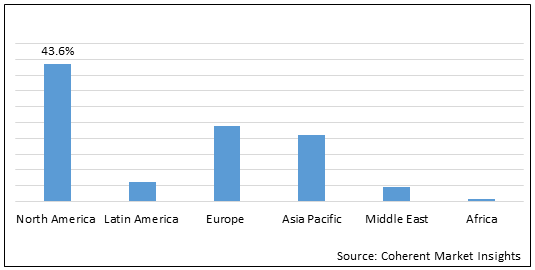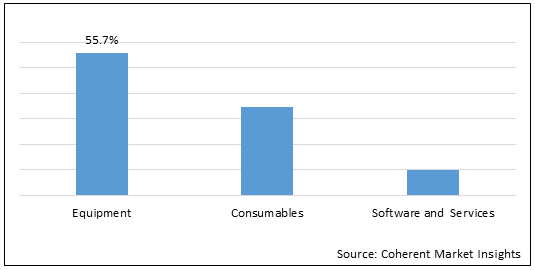The global live cell imaging market was valued at US$ 1,801.9 Mn in 2021 and is forecast to reach a value of US$ 2,921.9 Mn by 2028 at a CAGR of 7.2% between 2022 and 2028. The global live cell imaging market is experiencing strong growth owing to the increase in disease burden and growing geriatric population across the globe. Moreover, rise in adoption of high-content screening techniques in drug discovery is expected to boost the growth of the market. However, factors such as high cost of high-content screening systems & shortage of skilled professionals are expected to restrain growth of the live cell imaging market.
Global Live Cell Imaging Market: Regional Insights
Based on geography, the global live cell imaging market is segmented into North America, Latin America, Europe, Asia Pacific, and Middle East & Africa.
Among regions, North America is expected to gain highest share in the market over the forecast period due to the increasing prevalence of cancer in this region, especially in the United States. The use of live cell imaging has increased owing to the rising incidence of cancer in the U.S. For instance, according to the American Cancer Society, in 2022, there will be an estimated 1.9 million new cancer cases diagnosed and 609,360 cancer deaths in the United States.
Europe is also expected to witness robust growth in the global live cell imaging market due to the rising incidence of chronic disease (such as cancer, neurodegeneration, & cardiac diseases) and rising government funding. The Cancer Research UK and Wellcome Trust are increasingly funding research in cell and developmental biology. Universities and private research institutes are also making the technology more accessible to yield faster results.
Figure 1. Global Live Cell Imaging Market Share (%), by Region, 2021

To learn more about this report, Download Free Sample
Global Live Cell Imaging Market Drivers:
Increasing prevalence of chronic diseases such as cancer, neurodegeneration, & cardiac disease across the globe is expected to boost the growth of the global live cell imaging market over the forecast period. The demand for live cell imaging is increasing due to the high incidence of chronic diseases and the corresponding need for rapid diagnostic techniques. According to the Centers for Disease Control and Prevention (CDC), six in ten Americans live with at least one chronic disease, and these diseases are the leading causes of death and disability in the United States, and they are also a leading driver of health care costs.
Increase in development and adoption of live cell imaging system is expected to augment the growth of the global live cell imaging market during the forecast period. For instance, in May 2020, CytoSMART Technologies announced the launch of the new live-cell imaging system. The CytoSMART Lux2 Duo Kit offers straightforward, cost-effective solution for researchers carrying out immediate side-by-side comparisons between cell cultures.
Live Cell Imaging Market Report Coverage
| Report Coverage | Details | ||
|---|---|---|---|
| Base Year: | 2021 | Market Size in 2022: | US$ 1,924.4 Mn |
| Historical Data for: | 2017 to 2020 | Forecast Period: | 2022 to 2028 |
| Forecast Period 2022 to 2028 CAGR: | 7.2% | 2028 Value Projection: | US$ 2,921.9 Mn |
| Geographies covered: |
|
||
| Segments covered: |
|
||
| Companies covered: |
Thermo Fisher Scientific Inc., Merck KgaA, PerkinElmer Inc., Nikon Instruments Inc., Live Cell Instrument, Olympus Corporation, Danaher Corporation, CytoSMART Technologies, ZEISS Group, and Becton, Dickinson and Company, among others |
||
| Growth Drivers: |
|
||
| Restraints & Challenges: |
|
||
Uncover macros and micros vetted on 75+ parameters: Get instant access to report
Global Live Cell Imaging Market Opportunities:
Increasing adoption of live cell imaging in personalized medicines is expected to offer lucrative growth opportunities for players in the live cell imaging market. For instance, in September 2021, PHC Corporation of North America and Screen Holdings Co., Ltd. partnered to market the Screen Cell imager series of live cell imaging systems in North America. These innovative imaging instruments enable organoid and spheroid imaging with excellent accuracy using high-throughput, high-speed, and non-invasive technology for cellular research, drug discovery, and cosmetic and biopharmaceutical applications.
Increasing usage of live cell imaging is expected to provide lucrative growth opportunities for players in the global live cell imaging market. For instance, according to the study published in November 2021 in Trends in Biotechnology (Journal), microscopy imaging of living cells is being used in metabolic engineering to examine molecular dynamics in industrial microbes. This will lead open opportunities for live cell imaging in future.
Global Live Cell Imaging Market Trends:
Increasing geriatric population across the globe is expected to propel growth of the global live cell imaging market. For instance, growing aging population demands for intensive research in chronic diseases such as cancer, neurodegeneration, and cardiac diseases. According to the UN (United Nations), worldwide, the share of the population aged 65 years or over is expected to increase from 9.3 per cent in 2020 to around 16.0 per cent in 2050.
Increasing development of innovative standalone systems is expected to aid in the growth of the live cell imaging market. For instance, in April 2022, CytoSMART Technologies launched the CytoSMART Omni FL, a next-generation live-cell imaging analysis system incorporating red and green fluorescence channels into its signature CytoSMART Omni product line.
Global Live Cell Imaging Market Restraints:
Dearth of skilled professionals is expected to hamper the growth of the global live cell imaging market. Live cell imaging technology requires highly skilled professionals to understand and study the functions of cells. Thus, the shortage of skilled professionals is likely to hinder growth of the global live cell imaging market.
High cost of high-content screening systems is expected to hinder growth of the global live cell imaging market. For instance, high-content screening systems (HCS) instruments are equipped with advanced cell imaging and analysis features and functionalities, and thus are priced at a premium. A confocal microscope can cost more than US$ 200,000. The In-Cell 2000 Analyzer system (from GE Healthcare) used in HCS costs around US$ 240,000.
Figure 2. Global Live Cell Imaging Market Share (%), by Product, 2021

To learn more about this report, Download Free Sample
Global Live Cell Imaging Market Segmentation:
The global live cell imaging market report is segmented into Product, Application, and Region.
Based on Product, the market is segmented into Equipment, Consumables, and Software and Services. Out of which, Equipment Segment is expected to dominate the live cell imaging market over the forecast period and this is attributed to the rising usage of standalone systems. Standalone systems are referred to as equipment/devices that are able to function independently of other hardware and are not integrated into another device.
Software and Services Segment is also expected to witness robust growth during the forecast period and this is owing to the technological advancements in live cell imaging software and services. Several market players are offering sophisticated cellular imaging & analysis software to help user acquire, visualize, analyze, and share image data more effectively and efficiently, so that users spend more time searching.
Based on Application, the market is segmented into Cell Biology, Developmental Biology, Stem Cell Biology, Drug Discovery, and Other Applications. Of which, Cell Biology Segment is expected to dominate the application segment due to rising number of researchers working on molecular interaction networks. Cell biologists utilize live cell imaging to understand the fundamental cellular structures and their interaction on the tissue level.
Developmental Biology Segment is also expected to witness robust growth in the near future and this is owing to the use of live cell imaging in observation of cell embryogenesis and to study the physiological state of the cell. Developmental biology allows researchers to view the cell activity and proliferation throughout the developmental procedure.
Global Live Cell Imaging Market: Key Developments
In July 2021, Becton, Dickinson and Company announced the launch of bdbiosciences.com web and e-commerce site, a digital marketplace to enhance online purchase of BD research solutions including clinical and single-cell multiomic products.
In January 2021, ZEISS GROUP announced the launch of ZEISS Visioner 1, an innovative digital microscope that facilitates all-in-one focus in real time through its Micro-mirror Array Lens System (MALS), simplifying the imaging process and delivering higher throughput.
In August 2021, CytoSMART Technologies announced the launch of CytoSMART Lux3 BR, a new bright field live cell imaging system. It is a small bright field microscope, equipped with a high-quality 6.4 MP CMOS camera launched to support label-free live cell imaging process.
Global Live Cell Imaging Market: Key Companies Insights
The global live cell imaging market is highly competitive. This is attributed to the increase in adoption of high-content screening techniques in drug discovery, as a result, market players are focusing on launching novel techniques in the market.
Some of the key players in the global live cell imaging market are:
Thermo Fisher Scientific Inc., Merck KgaA, PerkinElmer Inc., Nikon Instruments Inc., Live Cell Instrument, Olympus Corporation, Danaher Corporation, CytoSMART Technologies, ZEISS Group, and Becton, Dickinson and Company, among others.
*Definition: Live cell imaging is the study of cellular structure and function in living cells via microscopy. It is used to obtain a better understanding of biological function through the study of cellular dynamics. In addition to basic research, live cell imaging plays an important role in drug discovery and development.
Share
Share
Missing comfort of reading report in your local language? Find your preferred language :
Transform your Strategy with Exclusive Trending Reports :
Frequently Asked Questions
Select a License Type
Joining thousands of companies around the world committed to making the Excellent Business Solutions.
View All Our Clients